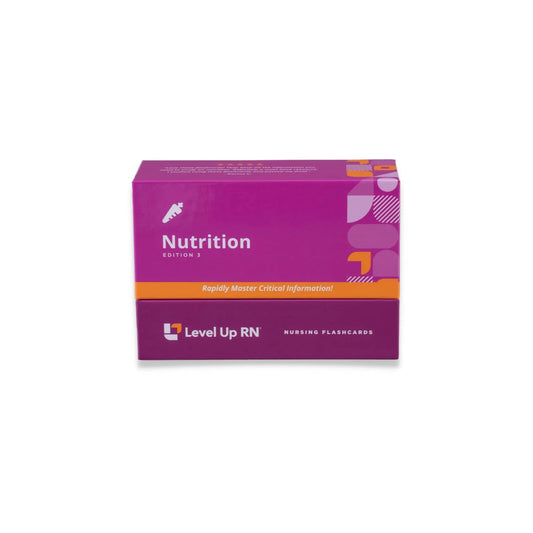Hi, I'm Cathy with Level Up RN. In this video, I'm going to continue my coverage of topics from our Level Up RN Nutrition Flashcard deck. Specifically, I'll be talking about diabetes and hypoglycemia, which is a key complication of diabetes. At the end of the video, I'm going to give you guys a quiz to test your understanding of some of the key points I'll be covering. So definitely, stay tuned for that. And if you have our Flashcards, go ahead and pull out your Flashcards on diabetes and hypoglycemia, so you can follow along with me.
Diabetes is an endocrine disorder characterized by chronic hyperglycemia or high blood glucose levels. This is due to insufficient insulin production by the pancreas or increased insulin resistance by the cells in the body. Signs and symptoms of diabetes include the three Ps. This includes polydipsia, which means increased thirst. Polyphagia, which means increased hunger, and polyuria, which means increased urination. Other symptoms include, weight loss, dehydration, a fruity breath odor, Kussmaul respirations, which is where we have an increase in the rate and depth of respirations, nausea, vomiting, lethargy, and warm, dry skin. Our cool chicken hint to help you remember the warm, dry skin is warm and dry, sugars high. Individuals with diabetes are advised to follow a carbohydrate-controlled diet as prescribed, and then insulin and oral antidiabetic agents should be administered as ordered. Keep in mind that individuals with type 1 diabetes are insulin-dependent. So oral antidiabetic agents are for individuals with type 2 diabetes only. The goal with therapy is to achieve an HGB A1C level under 7%. When it comes to diabetes, one thing to be familiar with is something called Somogyi phenomena. This is where the patient has morning hyperglycemia, so high blood sugar, due to overnight hypoglycemia or low blood sugar. In order to prevent Somogyi phenomenon, patients are advised to consume a snack with their nightly insulin dose.
Next, we're going to talk about hypoglycemia, which is defined as having a blood glucose level under 70 milligrams per deciliter. This is a key complication of diabetes that can be caused by excess insulin, decreased food intake, exercise, and excess alcohol. Signs and symptoms of hypoglycemia include hunger, irritability, confusion, diaphoresis, headache, shakiness, blurred vision, and pale, cold, clammy skin. Our cool chicken hint to help you remember the skin is cold and clammy, need some candy. Of note, hypoglycemia can also cause the patient to have a seizure or go into a coma. If an individual has hypoglycemia, and they are conscious, then they should consume approximately 15 grams of a readily absorbed carbohydrate, such as four ounces of juice or soda or eight ounces of milk. They should then recheck their blood glucose after 15 minutes. And if it is still under 70 milligrams per deciliter, they should once again consume 15 grams of a readily absorbed carbohydrate and then recheck their blood glucose after 15 minutes. Once the individual's blood glucose is over 70 milligrams per deciliter, they should consume a snack that contains a protein and a carbohydrate, such as cheese and crackers. Our cool chicken hint to help you remember this process is to remember the 15-15 rule. So 15 grams of a readily absorbed carbohydrate and wait 15 minutes to take the blood glucose again.
All right. It's quiz time, and I have four questions for you.
Question number one. Is diaphoresis and shakiness indicative of hyperglycemia or hypoglycemia?
The answer is hypoglycemia.
Question number two. The goal when treating diabetes is to maintain an HGB A1C level under blank percent.
The answer is 7.
Question number three, what do you call morning hyperglycemia due to overnight hypoglycemia?
The answer is Somogyi phenomenon.
Question number four. An individual with hypoglycemia should consume blank grams of a readily absorbed carbohydrate and recheck their blood sugar in blank minutes?
The answer is 15 and 15.
All right. That's it for this video. I hope it was helpful. Take care and good luck with studying.


